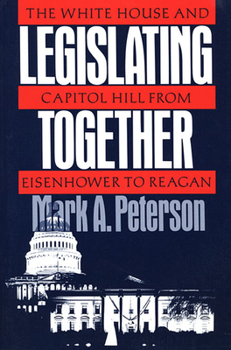Legislating Together: The White House and Capitol Hill from Eisenhower to Reagan
Select Format
Select Condition 
Book Overview
Mark Peterson investigates how recent presidents have engaged Congress on domestic policy issues. Rejecting the presidency-centered perspective on national government that is so firmly rooted in the popular imagination, he argues in this sophisticated analysis that the response of Congress to presidential initiatives is often far more cooperative than the presidency-centered perspective suggests.
Format:Paperback
Language:English
ISBN:0674524160
ISBN13:9780674524163
Release Date:January 1993
Publisher:Harvard University Press
Length:360 Pages
Weight:1.20 lbs.
Dimensions:1.1" x 6.1" x 9.2"
Customer Reviews
1 rating
A Move Away from the Presidency-Centered Perspective
Published by Thriftbooks.com User , 15 years ago
Peterson moves away from the "presidency-centered perspective" which contends that the president and Congress possess differing values and goals and are engaged in a zero-sum game. This approach argues that the president should be the legislative leaders. Peterson contends that such an approach is an incorrect representation of presidential-congressional relations. Rather, Peterson argues from a "tandem-institutions perspective" which suggests that both institutions function together to form a "legislative decision-making process." The institutional boundaries overlap and powers are shared. The institutions cannot act independently and as such, the "legislative decision-making process" is a quasi-institution in itself. As such, we can't look at each institution - in regards to legislating - as an independent entity. According to Peterson, in order to be successful, the president will have to form some kind of coalition with members of Congress in order for presidential initiatives to move forward. Peterson contends that Congress reacts in one of five ways to presidential initiatives: (1) inaction, where no action is taken and the proposal dies in committee, (2) there can be a lack of consensus and both sides - the president v. Congress - attempt to dominate the bill. Usually one side dominates the other. When Congress dominates, the initiative is killed, (3) compromise can occur and adjustments are made to the proposal. Here the president may not get everything he wants, but the proposal passes. Lastly, (4) consensus can occur and the presidential initiative sails through. This is usually the case when the bill in nonpartisan or the opposition is disorganized, or doesn't care. Peterson contends that there are four groups of variables which may shape the relationship between the president and congress, an ultimately affect the success of failure of the presidential initiative. The first fall under the "pure context," or those institutional aspects - and some changes to institutions - which are outside of presidential control, but affect the chances of implementation all the same. The first variable under the "pure context" contends that congressional decentralization has made it increasingly difficult to form the coalitions necessary to successfully pass an initiative. A second variable stems from the increasing number of interest groups, which has made consensus formation more difficult. Additionally, these interest groups can have a greater influence on congressional committees and individual legislators which create more decentralization in the parties. The next group of variables fall under the "malleable context" or those areas where the president has some, but unpredictable control. Here, we may look at issues like political capital, election cycles, and the state of the economy. The president can - to a point - influence these areas and they have an effect on congressional response to the initiatives. First, the temp






